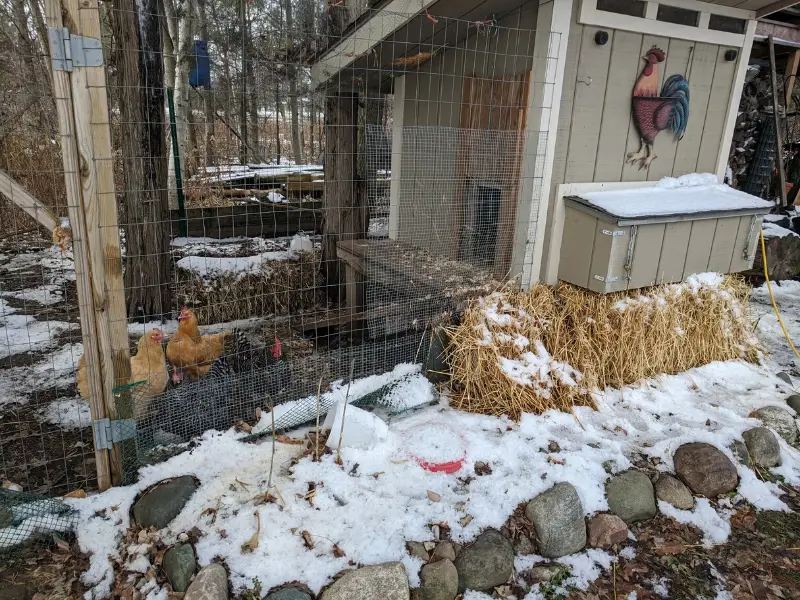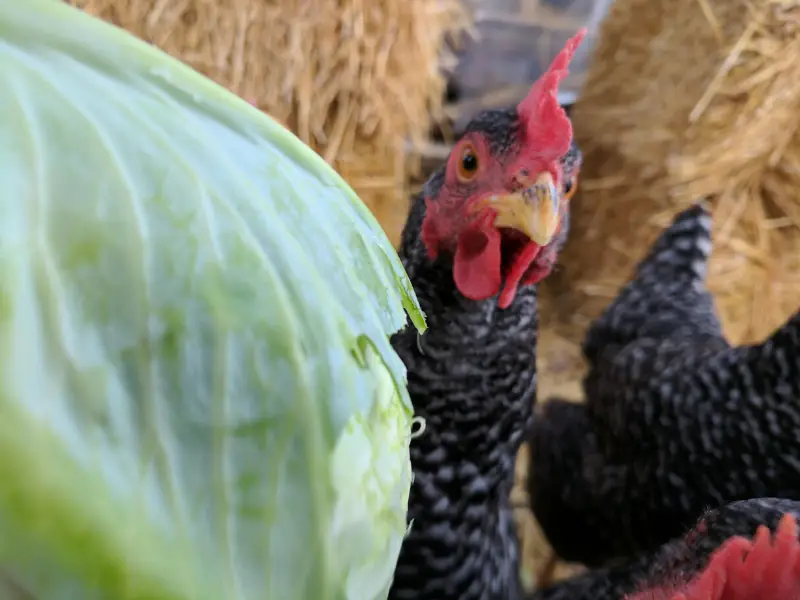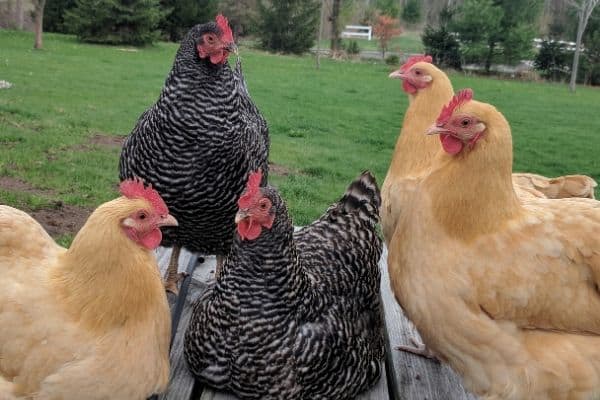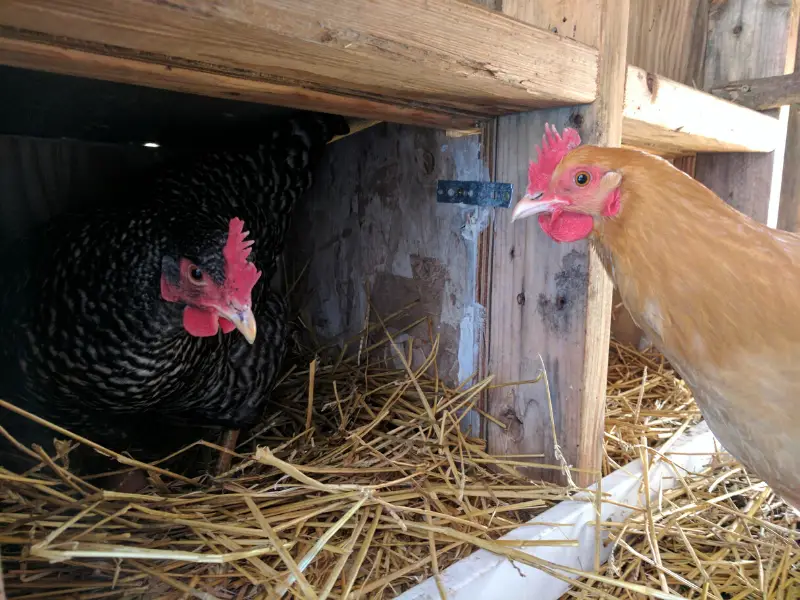Homesteaders and chicken owners want their chickens to be happy, healthy and safe. So of course you don’t want them to be cold in the winter months, but do they need a heat lamp or supplemental heat in the coop?
You may be surprised to know that: Chickens do not need a heat lamp in the winter. In fact a heat lamp is actually more dangerous due to the potential fire hazard and chickens not becoming acclimated to the cold and then losing the heat source if the power goes out during a cold spell.
I’ll share a story about a heat lamp disaster from a friend, our own success raising chickens in Michigan winters, and a few tips to ensure your flock stays safe and comfortable.
Dangers of Heat Lamps
Some friends of ours that lived a few miles away had a chicken coop attached to the back of their garage. They used a heat lamp to warm the coop during the winter. My friend Steve woke up to a faint smell of smoke and a flickering glow through the bedroom window. The garage was in flames!
By the time the fire department arrived the garage was a total loss and the house suffered damage to the exterior but otherwise was okay. The fire chief determined the cause was from the heat lamp in the chicken coop. The theory is that a chicken knocked it loose or it otherwise fell to the floor and ignited the pine shavings on the floor. The flames quickly spread to the garage that the coop was attached to.
I went over there the following day to see the aftermath and at that point I knew I would not ever use a heat lamp in the chicken coop. I don’t remember how many hens they had, but only one somehow managed to survive. I saw the survivor wandering the yard with singed feathers and a traumatized look in her eyes.
Here’s Why You Don’t Need Supplemental Heat
A lot of animals adjust to seasonal temperature fluctuations including many birds. Just picture that little chickadee or the blue jay that visits your bird feeder all winter long. Chickens are the same way. They will adjust to the cold weather just like the other animals in your locale.
If chickens are used to the coop always being nice and toasty warm and something happens to the heat source, they will not be acclimated to the cold temperatures. There could be a power outage or equipment failure. If chickens had to go from 50 degrees every day to single digits the next, they would actually be in danger of freezing to death. Whereas chickens that naturally acclimate to colder temps can easily handle extreme cold conditions.
Long before rural farms had electricity running to them, homesteaders kept chickens successfully. They did this without supplemental heat sources. Shelter from wind, rain and snow is all the chickens needed.
Chickens will typically molt and grow fresh new feathers in the fall. These fresh new feathers will act as insulation for the chickens when they puff them up and trap air inside them. As long as the chickens are sheltered from the wind and stay dry that is all they need to stay warm.
If you live in an area that experiences long cold winters you should choose a breed of chicken that tolerates the cold weather well. Characteristics of cold-hardy chickens include fluffy feathers and small combs & wattles that resist frostbite better. Personally, we have Buff Orpingtons and Barred Rocks and have had no problems keeping these hens through several cold Michigan winters. I have a video on YouTube regarding this topic.
Here’s a list of cold-hardy breeds I found from HGTV:
- Orpington
- Rhode Island Red
- New Hampshire Red
- Plymouth Barred Rock
- Wyandotte
- Delaware
- Australorp
- Ameraucana
Winterizing the Coop and Run
Winterizing the coop takes nothing more than adding fresh straw or pine shavings to the nest boxes and floor of the coop to give some insulation. If you have extra ventilation for the warm months now is the time to close some of them. The coop must be ventilated somewhat even in the winter to allow waste gasses to escape.
In our coop, I also add the heated watering system and indoor feeding tube. I made both of these from PVC pipe. To keep the water from freezing I use a plug-in type thermostat and an aquarium heater inside the PVC tube. I have a YouTube video of that heater here.
To help give them a protected area outside in the run I make a perimeter of straw bales stacked up around the coop. The south end is left open to get into the bigger part of the run, but the straw blocks the wind around the rest of coop so the girls can go under the coop to stay out of the wind. The outside feeder also opens under the coop to give the girls access without the opening filling with snow and ice.

If it gets extremely cold or very low windchill we will leave the coop door closed most of the day to protect the hens from the cold. We do keep food an water in the coop during the winter months for that reason. Keeping them cooped up once in a while is okay, but shouldn’t be done all the time or some in-fighting may occur. Here’s another article on this site talking more about this subject.
Warm Treats to Keep Your Hens Happy
On those extremely cold mornings, Maria will usually make the girls some warm treats to warm their bellies. This could be oatmeal or barley with some banana and flackseed mixed in. They absolutely love it and gobble it right up.

We let our chickens free range during the day most of the year. Therefore they are used to foraging on greens during that time, so we also like to give them supplemental greens such as cabbage or lettuce occasionally during the winter months. We feel this keeps them healthy by adding a little variety in their diet. I like to cut a head of cabbage in half and poke a hole through one end. Through this hole, I’ll thread a piece of twine to tie on the fence of the coop. It also gives them something different to do for awhile when cabin…eh coop fever starts to set in.

Forced Laying?
Another thing to consider is whether to use a lighting source to trick the hens into laying through the winter. We don’t do this and here’s why. A hen is born with all the eggs she’ll ever have. If you force laying through the winter she may lay all her eggs in a year and half and then unless you cull her from the flock you’re be feeding a free-loader hen that isn’t producing any more eggs. We prefer to let the girls go dormant in the winter and extend their egg-laying into their later years.
Forcing them to lay with extended artificial light also requires them to take in more nutrients and vitamin D which are plentiful in the summer while free-ranging, but need to supplemented in the winter to keep them healthy. We feel it’s best to give their bodies a break for a few months and avoid over stressing them during the cold weather. Less eggs in the winter also means less eggs lost due to freezing before you can fetch them.
We get around the winter egg shortage by stocking up for a while in the fall, freezing some breakfast casseroles, and pickling hard-boiled eggs. You can also crack them and freeze them for use later, but we haven’t tried this yet. Occasionally we’ll have to buy a few dozen as winter drags along, but as soon as the days start getting noticeably longer and a little warmer, the egg production starts to pick back up.
I encourage you to provide a snug environment for your chickens, but please refrain from using a heat lamp in the coop. Your chickens will be happy and comfortable without one.





